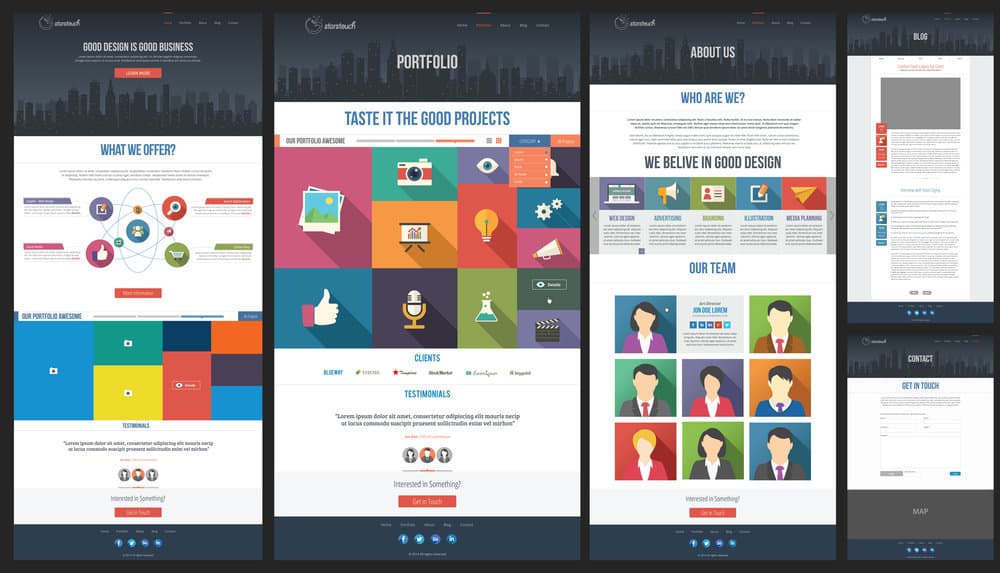To shed light on the ideal length of a legal landing page, we’ve gathered insights from nine industry professionals, including B2B Conversion Copywriters and CEOs. From presenting a comprehensive service overview to adjusting the length to service complexity, these experts share their perspectives on this crucial aspect of digital marketing.
- Present a Comprehensive Service Overview
- Tailor the Length to Conversion Goal
- Let the Content Determine Length
- Structure the Page as Step-by-Step Guide
- Prioritize Effective Communication Over Length
- Consider Audience Comprehension and Attention Span
- Follow the Rule of AIR
- Balance Information and Conciseness
- Adjust the Length to Service Complexity

1. Present a Comprehensive Service Overview
Start with the technicalities: the services you offer, the areas of law in which you specialize, the locations you cover, and what makes your practice special. Is it your ethics? Your communication and updates? Your accessibility? Your speed? Your creativity? (Make sure to back up each claim with a testimonial, a case study, or numbers that show you’re walking the talk.)
Then, build another layer of trust with impressive stats, like how much money you brought in for clients, the results you’ve gotten, the number of days to get a case closed, or years of experience. Sprinkle in high-profile client logos or knockout testimonials that show off your experience, level of service, and the results you’ve gotten for clients.
Finally, finish off with your contact info, and you’ve just presented your most powerful face to the web, and to the thousands of potential visitors who’ve just been inspired to choose your firm to represent them.
Devorah Hager, B2B Conversion Copywriter, Sapphire Copy
2. Tailor the Length to Conversion Goal
The length of a legal landing page hinges, fundamentally on your specific conversion goal. Remember, the objective is to provide enough information for visitors to make informed decisions, without overwhelming them.
Once, we were developing a legal landing page for a new service. It started out fairly short, but we found conversions weren’t quite up to par. We expanded the content after some tweaks and tests to elucidate the legal complexities involved. This resulted in a surge in conversions. So, tailor your page length to your goal.
Daniel Pfeffer, CEO, Scrape Network
3. Let the Content Determine Length
Information is key; determination of length is secondary.
You will find a healthy mix of information, statistics, customer testimonials, CTAs, and crucial highlights of our expertise and experience on our landing page.
The page reveals to potential clients everything they need to know to place their trust in our abilities. Even at first glance, the information on the page is enough to drive home the point that a client’s recovery is most important to us.
If we had to determine the page length first, we would have probably restricted some of this information or shifted some insights to other pages. Instead, we let our content decide, and the approach has worked well for us.
Riley Beam, Managing Attorney, Douglas R. Beam, P.A.
4. Structure the Page as Step-by-Step Guide
The ideal length of a legal landing page may vary, but structuring it as a step-by-step guide is crucial. This approach ensures clarity and provides value to potential clients.
By breaking down complex legal processes into manageable steps, users can easily understand what to expect. Whether the page is short or long, the focus should be on presenting information clearly and organized.
For example, a legal landing page for a divorce attorney could include steps like “Understanding Your Options,” “Filing for Divorce,” and “Negotiating Settlements.” This format caters to users who prefer a detailed explanation, ultimately helping them make informed decisions.
Ben Lau, Founder, Featured SEO Company
5. Prioritize Effective Communication Over Length
There’s no right length for landing pages, be it a legal landing page or some other. However, the minimum ideal number should be 300 words from an SEO perspective. “300” words is the minimum number as Google sees this number as one of its ranking factors.
The main point is that the way you speak about your legal services and get clients interested in them is what counts. It means you must communicate successfully: Why should your audience choose you? In other words, what makes you stand out from the competition?
How can your legal services benefit them?
Once you fulfill the above criteria, there’s no need to worry about how long the page length should be. As long as you focus on providing value, strict word counts do not matter, but keeping the copy at least 300 words is essential for SEO reasons.
Zeeshan Rashid, Digital Marketing Specialist, Musheer.com
6. Consider Audience Comprehension and Attention Span
We once had a legal landing page that was quite detailed, running close to a thousand words. However, we noticed that engagement was dropping off halfway through. Upon surveying our users, we realized that our clientele, often busy healthcare professionals, preferred concise, to-the-point information.
We revised the page to 300 words, maintaining only the essential legal points. The response was overwhelmingly positive. It taught me that comprehension and attention span of the audience play a pivotal role in deciding the length of such pages.
Hafsa Unnar, Executive Assistant, On-Site First Aid Training
7. Follow the Rule of AIR
Following the rule of AIR—awareness, intent, and referral—on a landing page is key to developing the ideal page length. Awareness guides what the brand does and, most specifically, what they do best. This lines up with intent, which is why the customer is on the landing page in the first place: the services offered by the brand.
These two elements need to be sleek, integrated, and to the point to avoid overcrowding the page and encourage quick and efficient click-through. Referral sources then add credibility, which is always great to add validity to the site overall and keep things from being too minimal.
Max Schwartzapfel, CMO, Schwartzapfel Lawyers
8. Balance Information and Conciseness
The ideal length of a legal landing page for a law firm can vary depending on the specific goals of the page, the complexity of the legal services being offered, and the preferences of your target audience. However, a general guideline to consider is to keep your landing page concise and focused while providing enough information to address your potential clients’ key needs and questions.
One important factor that determines the ideal length of a legal landing page is content relevance. Your landing page should include enough content to convey essential information about your law firm’s expertise, services, and how you can address potential clients’ legal needs. It’s important to balance providing sufficient information and not overwhelming visitors with an excessively long page.
Richard Frankel, Attorney / Owner, Bross & Frankel, PA
Adjust the Length to Service Complexity
Aim for a length that effectively conveys key information without overwhelming visitors with superfluous information. A landing page should be concise and cover essential points, benefits, and a call to action.
The complexity of your legal services is crucial in determining page length. If your products or services are simple, a shortened page may suffice. However, if the services involve complex legal issues, a slightly longer page may be required to elucidate the nuances adequately.
Remember that the primary objective of a landing page is to capture the visitor’s attention, establish trust, and motivate them to take the desired action. Concentrate on delivering an irresistible value proposition and emphasizing your expertise. Prioritize concise and convincing content over excessive length.
Michael Callahan, Founder and Director, The Callahan Law Firm
Additional Tips for an Effective Legal Landing Page
- Mobile-friendly Design – A majority of web traffic comes from mobile devices. Ensure your landing page is responsive and navigable on all screen sizes.
- Clear Call to Action (CTA) – Guide your visitors to the next step with a distinct and compelling CTA.
- Testimonials – Incorporate testimonials or case studies to enhance credibility and reliability.
- Quality Over Quantity – Delivering quality content rather than filling the page with excessive text.
- SEO Optimization – Use keywords strategically in your content to improve your landing page’s visibility on search engines.
- A/B Testing – Utilize A/B testing to determine the most effective landing page design, structure, and content.
- Visuals – Incorporate relevant visuals to make the page more engaging and easier to navigate.
- Loading Speed – Optimize your landing page for quick load times to improve user experience and decrease bounce rates.
Remember, the ultimate goal of a legal landing page is to convert visitors into clients. These suggestions should serve as a roadmap to creating an effective and optimized legal landing page.
Frequently Asked Questions
How long should a legal landing page be for optimal performance?
The length can vary depending on factors such as the complexity of the legal services offered and your target audience’s preferences. However, as a general guideline, your landing page should be concise and focused while providing enough information to address the needs and questions of your potential clients.
What elements are important to include on a legal landing page?
Include a clear value proposition, details about your law firm’s services and expertise, and a compelling call to action. Testimonials can also enhance credibility, and SEO optimization can improve visibility on search engines.
How should I adjust the length of my landing page based on my legal services?
If your legal services are simple, a shorter landing page may suffice. However, a longer page may be required to explain nuances adequately for complex legal issues. Remember, the page should effectively convey key information without overwhelming visitors.
How important is design in a legal landing page?
Design is crucial. Ensure your landing page is mobile-friendly, includes relevant visuals, and loads quickly to improve user experience and reduce bounce rates.
What is A/B testing and why is it relevant?
A/B testing involves comparing two versions of a page to see which performs better. It can help you determine your landing page’s most effective design, structure, and content.










